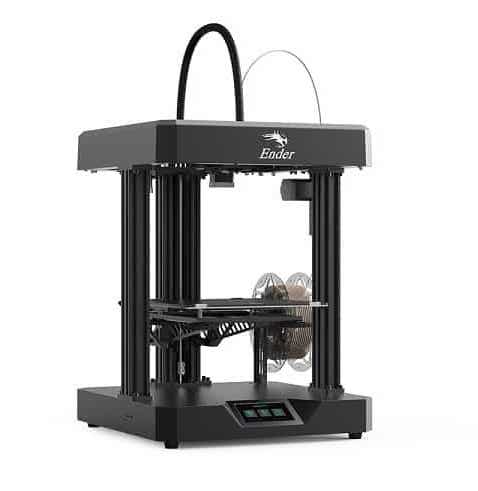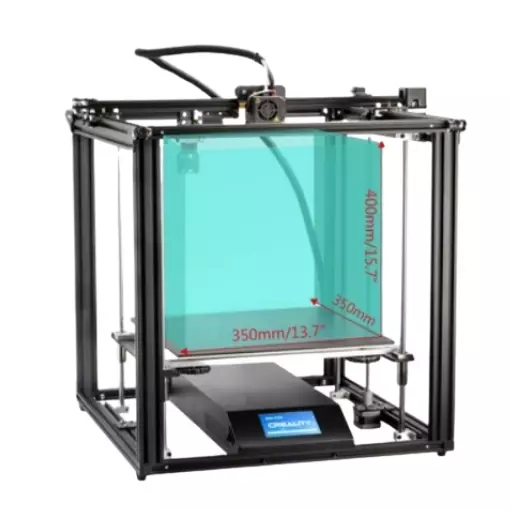Compare Ender 7 vs Ender 5 Plus
Comparison between the best 3D printers
Choose the best 3D printer at the best price. The cheapest 3D printers are here.
Buy a 3D printer here with 3D Fila.
 |
 |
|
| Model | Ender 7[BUY Ender 7] |
Ender 5 Plus[BUY Ender 5 Plus] |
| Printing Material | Filament | Filament |
| Buy Filament for Creality 3D Ender 7 | Buy Filament forCreality 3D Ender 5 Plus | |
| Estimated price | $429,00 | $599,00 |
| Manufacturer | Creality 3D | Creality 3D |
| Release Year | 2021 | 2019 |
| Print Volume [mm] | 250x250x300 | 350x350x400 |
| Printer Size [mm] | 430x460x570 | 632x619x666 |
| Weight [kg] | 17,2 | 18,2 |
| Power Loss Recovery | YES | YES |
| Enclosed printer | NO | NO |
| Bed Leveling | Manual | Automatic |
| Filament End Sensor | YES | YES |
| Bed type | Heated | Heated |
| Power supply system | Bowden | Bowden |
| Standard nozzle | 0,4 | 0,4 |
| Maximum Nozzle Temperature [°C] | 260 | 260 |
| Maximum Bed Temperature [°C] | 100 | 100 |
| Maximum printing speed [mm/s] | 250 | 180 |
| Filament holder | YES | YES |
| Camera for supervision | NO | NO |
| Recommended filaments | PLA, PETG, Tritan, Flex, ABS | PLA, TPU, ABS, PETG |
| Recommended slicers | Cura, Simplify, Slic3r, IdeaMaker | Cura, Simplify, Slic3r |
| Maximum Resolution [mm] | 0,1 | 0,1 |
| Processor | Creality CR-FDM V.2.4.S1_V101 32bits | 32 bits |
| Display | Display touchscreen 4,3'' | Touchscreen TFT 4,3'' |
| Power Supply | 110/220V / 350W | 24V / 504W |
| Connectivity | SD / USB | SD / USB |
| Operating systems | Windows, Mac, Linux | Windows, Mac, Linux |
| Date of registration in the system | 2022-11-04 | 2021-04-14 |
| Release date | 2021 | 2019 |
| Extra features | Crealitys Ender 7 printer offers remarkable print speeds, utilizing CoreXY kinematics for precise and fast movement. With a 250x250x300mm build area, dual direct extruder, and custom hotend, the Ender 7 is capable of printing at high speeds, although quality may suffer on smaller prints. Assembly is relatively straightforward, but the machine is noisy and can get hot. Its true speed potential is most noticeable on larger prints, where it outperforms its competitors. | The Ender 5 Plus offers a large print volume (350x350x400 mm) and fast assembly. It includes a BLTouch sensor, but with range limitations. It stands out for its dimensional accuracy, although it requires adjustments to the slicer settings. Despite the noise, its integrated design saves space, and includes features such as a filament sensor and power resumption. Ideal for large projects, it requires refinement in the settings for high-quality prints. |
| Support for multiple colors and materials (AMS and CFS) | NO | NO |
Notes * |
||
| Cost-benefit | 7 / 10 | 6 / 10 |
| Hardware | 2 / 10 | 2 / 10 |
| Tela | . | . |
| Print volume | 4 / 10 | 4 / 10 |
| Performance | 2 / 10 | 1 / 10 |
| [BUY Ender 7] | [BUY Ender 5 Plus] |
Conclusion |
| In comparing the Ender 7 and Ender 5 Plus 3D printers, the Ender 7 stands out as a more cost-effective option, offering faster print speeds and straightforward assembly at a lower price point. Its CoreXY kinematics enable rapid movements, which particularly benefit larger prints, although there may be trade-offs in quality on smaller ones. The Ender 7 also features a reasonable print volume and a solid array of features, including a dual direct extruder and filament sensor. On the other hand, the Ender 5 Plus provides a larger print volume and automatic bed leveling, ideal for those focused on dimensional accuracy in larger projects. However, it is generally more expensive and requires additional adjustments to achieve optimal print quality. Ultimately, if speed and affordability are primary concerns, the Ender 7 is the better choice, while those needing a larger build space and precise accuracy may find the Ender 5 Plus to be more suitable, despite its higher cost. The decision should be based on individual printing needs and budget considerations. |

